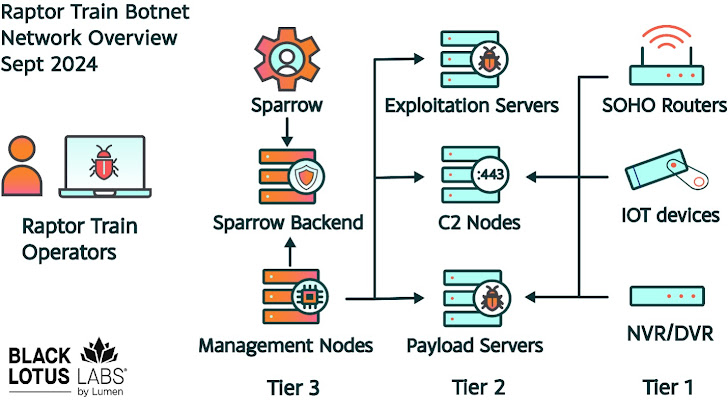THN Cybersecurity Recap: Last Week's Top Threats and Trends (September 16-22)
|
|
|
|
|
|
|
Powered by: |
Older messages
Critical Ivanti Cloud Appliance Vulnerability Exploited in Active Cyberattacks
Saturday, September 21, 2024
THN Daily Updates Newsletter cover Not with a Bug, But with a Sticker: Attacks on Machine Learning Systems and What To Do About Them ($17.00 Value) FREE for a Limited Time A robust and engaging account
Critical Ivanti Cloud Appliance Vulnerability Exploited in Active Cyberattacks
Friday, September 20, 2024
THN Daily Updates Newsletter cover Generative AI in Practice: 100+ Amazing Ways Generative Artificial Intelligence is Changing Business and Society ($23.00 Value) FREE for a Limited Time An
Alert - GitLab Patches Critical SAML Authentication Bypass Flaw in CE and EE Editions
Thursday, September 19, 2024
THN Daily Updates Newsletter cover Not with a Bug, But with a Sticker: Attacks on Machine Learning Systems and What To Do About Them ($17.00 Value) FREE for a Limited Time A robust and engaging account
Exclusive: Top SaaS Security Threats of 2025—And How to Eliminate Them
Wednesday, September 18, 2024
Learn how 39% of companies are stepping up their defenses.
Patch Issued for Critical VMware vCenter Flaw Allowing Remote Code Execution
Wednesday, September 18, 2024
THN Daily Updates Newsletter cover [Watch LIVE] Solving the SIEM Problem: A Hard Reset on Legacy Solutions From Overload to Oversight: How Modern SIEM Solutions Can Simplify Security Without
You Might Also Like
📧 Did you watch the FREE chapter of Pragmatic REST APIs?
Friday, February 28, 2025
Hey, it's Milan. 👋 The weekend is almost upon us. So, if you're up for some quality learning, consider watching the free chapter of Pragmatic REST APIs. Scroll down to the curriculum or click
Data Science Weekly - Issue 588
Thursday, February 27, 2025
Curated news, articles and jobs related to Data Science, AI, & Machine Learning ͏ ͏ ͏ ͏ ͏ ͏ ͏ ͏ ͏ ͏ ͏ ͏ ͏ ͏ ͏ ͏ ͏ ͏ ͏ ͏ ͏ ͏ ͏ ͏ ͏ ͏ ͏ ͏ ͏ ͏ ͏ ͏ ͏ ͏ ͏ ͏ ͏ ͏ ͏ ͏ ͏ ͏ ͏ ͏ ͏ ͏ ͏ ͏ ͏ ͏ ͏ ͏ ͏ ͏ ͏ ͏ ͏ ͏ ͏
💎 Issue 458 - Why Ruby on Rails still matters
Thursday, February 27, 2025
This week's Awesome Ruby Newsletter Read this email on the Web The Awesome Ruby Newsletter Issue » 458 Release Date Feb 27, 2025 Your weekly report of the most popular Ruby news, articles and
📱 Issue 452 - Three questions about Apple, encryption, and the U.K
Thursday, February 27, 2025
This week's Awesome iOS Weekly Read this email on the Web The Awesome iOS Weekly Issue » 452 Release Date Feb 27, 2025 Your weekly report of the most popular iOS news, articles and projects Popular
💻 Issue 451 - .NET 10 Preview 1 is now available!
Thursday, February 27, 2025
This week's Awesome .NET Weekly Read this email on the Web The Awesome .NET Weekly Issue » 451 Release Date Feb 27, 2025 Your weekly report of the most popular .NET news, articles and projects
💻 Issue 458 - Full Stack Security Essentials: Preventing CSRF, Clickjacking, and Ensuring Content Integrity in JavaScript
Thursday, February 27, 2025
This week's Awesome Node.js Weekly Read this email on the Web The Awesome Node.js Weekly Issue » 458 Release Date Feb 27, 2025 Your weekly report of the most popular Node.js news, articles and
💻 Issue 458 - TypeScript types can run DOOM
Thursday, February 27, 2025
This week's Awesome JavaScript Weekly Read this email on the Web The Awesome JavaScript Weekly Issue » 458 Release Date Feb 27, 2025 Your weekly report of the most popular JavaScript news, articles
💻 Issue 453 - Linus Torvalds Clearly Lays Out Linux Maintainer Roles Around Rust Code
Thursday, February 27, 2025
This week's Awesome Rust Weekly Read this email on the Web The Awesome Rust Weekly Issue » 453 Release Date Feb 27, 2025 Your weekly report of the most popular Rust news, articles and projects
💻 Issue 376 - Top 10 React Libraries/Frameworks for 2025 🚀
Thursday, February 27, 2025
This week's Awesome React Weekly Read this email on the Web The Awesome React Weekly Issue » 376 Release Date Feb 27, 2025 Your weekly report of the most popular React news, articles and projects
February 27th 2025
Thursday, February 27, 2025
Curated news all about PHP. Here's the latest edition Is this email not displaying correctly? View it in your browser. PHP Weekly 27th February 2025 Hi everyone, Laravel 12 is finally released, and

